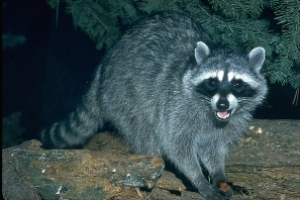Raccoons are extremely tactile and spend much time feeling items of interest with their front paws. They often make "washing" movements with a potential food item with or without water before eating.
Photo Credit: Lloyd Ingles
Procyon lotor
Common Name: raccoon
Other Common Names: common raccoon, coon, northern raccoon
Animal Guild: Mammal
Class > Order > Family: Mammalia > Carnivora > Procyonidae
What does the species look like?
Raccoons are familiar medium-sized carnivores, weighing up to 22 kg (48 lb). The coat is grizzled grey black, with a distinctive black mask outlined with white across the eyes. The tail is large and has conspicuous black bands.
Where is the species found?
States & Provinces
AB, AL, AR, AZ, BC, CA, CO, CT, DE, FL, GA, IA, ID, IL, IN, KS, KY, LA, MA, MB, MD, ME, MI, MN, MO, MS, MT, NB, NC, ND, NE, NH, NJ, NM, NS, NV, NY, OH, OK, ON, OR, PA, PE, QC, RI, SC, SD, SK, TN, TX, UT, VA, VT, WA, WI, WV, WY
Distribution
The raccoon is found from central Canada south through the United States and Central America to Panama, though it is absent at high elevations and in hot dry areas. It has been introduced to several locations in Asia and Europe.
Raccoons are very adaptable and occur in almost every natural, agricultural, suburban, and urban habitat type except high elevations and extremely dry desert. Their food habits are also very broad, including a wide range of plant and animal material.
General Phenology and Life History
Young are born in late winter. When about two months old, they begin to accompany the mother outside the den while she forages. While raccoons are not very active during very cold or snowy periods in winter, they do not hibernate.
Which phenophases should I observe?
Do you see/hear...?
Activity
Live individuals More...
For abundance, enter the number of individual animals observed in this phenophase.
Feeding For abundance, enter the number of individual animals observed in this phenophase.
Fruit/seed consumption For abundance, enter the number of individual animals observed in this phenophase.
Development
Young individuals For abundance, enter the number of individual animals observed in this phenophase.
Dead individuals For abundance, enter the number of individual animals observed in this phenophase.
What do these phenophases look like?
There is currently no photoguide available for this species. If you'd like help us create one, use the guidance document and species template provided here . Then send it via email to education@usanpn.org when it is complete.
